
Lucca is a city and comune in Tuscany, Central Italy, on the Serchio River, in a fertile plain near the Ligurian Sea. The city has a population of about 89,000, while its province has a population of 383,957.

Romanesque architecture is an architectural style of medieval Europe that was predominant in the 11th and 12th centuries. The style eventually developed into the Gothic style with the shape of the arches providing a simple distinction: the Romanesque is characterized by semicircular arches, while the Gothic is marked by the pointed arches. The Romanesque emerged nearly simultaneously in multiple countries ; its examples can be found across the continent, making it the first pan-European architectural style since Imperial Roman architecture. Similarly to Gothic, the name of the style was transferred onto the contemporary Romanesque art.

The Sanctuary of Saint Michael the Archangel is a Roman Catholic shrine on Mount Gargano, Italy, part of the commune of Monte Sant'Angelo, in the province of Foggia, northern Apulia. It has the dignity of a minor basilica.
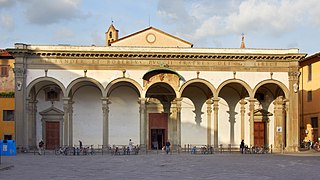
The Basilica della Santissima Annunziata is a Renaissance-style, Catholic minor basilica in Florence, region of Tuscany, Italy. This is considered the mother church of the Servite Order. It is located at the northeastern side of the Piazza Santissima Annunziata near the city center.

The Via Francigena is an ancient road and pilgrimage route running from the cathedral city of Canterbury in England, through France and Switzerland, to Rome and then to Apulia, Italy, where there were ports of embarkation for the Holy Land. It was known in Italy as the "Via Francigena" or the "Via Romea Francigena". In medieval times it was an important road and pilgrimage route for those wishing to visit the Holy See and the tombs of the apostles Peter and Paul.

Lucca Cathedral is a Roman Catholic cathedral dedicated to Saint Martin of Tours in Lucca, Italy. It is the seat of the Archbishop of Lucca. Construction was begun in 1063 by Bishop Anselm.

The Basilica of San Frediano is a Romanesque church in Lucca, Italy, situated on the Piazza San Frediano.
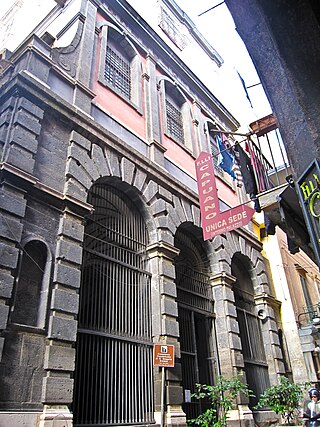
San Gregorio Armeno is a church and a monastery in Naples, Italy. It is one of the most important Baroque complexes in Naples. The church is located on a street of the same name just south of Via dei Tribunali and a few blocks south of the church of San Paolo Maggiore, Naples
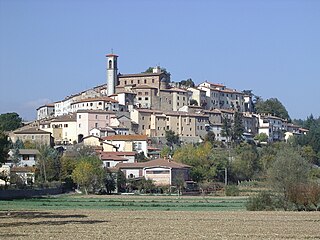
Monterchi is a Comune (Municipality) in the Province of Arezzo in the Italian region of Tuscany, located about 80 kilometres (50 mi) southeast of Florence and about 20 kilometres (12 mi) east of Arezzo. It sits in the northern part of Valtiberina, the valley where the Tiber river runs going from Emilia-Romagna towards Rome. The valley runs through Romagna, Tuscany and Umbria, parallel to the Casentino Valley.

Matteo Civitali (1436–1501) was an Italian Renaissance sculptor and architect, painter and engineer from Lucca. He was a leading artistic personality of the Early Renaissance in Lucca, where he was born and where most of his work remains.

San Frediano in Cestello is a Baroque-style, Roman Catholic church in the Oltrarno section of Florence, region of Tuscany, Italy. The name cestello derives from the Cistercians who occupied the church in 1628. Previously the site had a 1450s church attached to the cloistered Carmelite convent of Santa Maria degli Angeli.
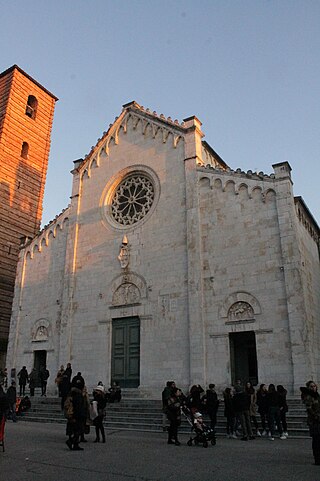
The Collegiate Church of San Martino is a collegiate church in Pietrasanta, in the region of Tuscany, Italy. It is the main church or duomo of the town. It is first mentioned in 1223, and was subsequently enlarged in 1330 and in 1387 when Pope Urban VI had a baptismal font installed in the church.

Santa Maria dei Miracoli presso San Celso is a church and a sanctuary in Milan, Lombardy, northern Italy.

Santuario della Madonna del Divino Amore, or the Shrine of Our Lady of Divine Love, is a Roman Catholic shrine in the southern outskirts of Rome dedicated to the Blessed Virgin Mary that consists of two churches: an old church built in 1745 and a new church added to the sanctuary in 1999. The church was included by Pope John Paul II in the pilgrimage of Seven Pilgrim Churches of Rome during the Holy Year 2000.
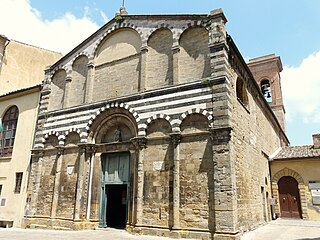
San Michele Arcangelo is a 13th-century Romanesque-style Roman Catholic church located on Via Guarnacci #6 in Volterra, province of Pisa, region of Tuscany, Italy. The church is across the street from the Medieval Palazzo Maffei-Guarnacci.

San Pietro alle Scale, also known as San Pietro in Castelvecchio is a Roman Catholic parish church located on via San Pietro, Terzo of Città, in Siena, region of Tuscany, Italy. Initially built in the 12th century, this parish church was completely rebuilt in a Baroque style in the 17th century; the brick facade has a portal with a depiction of Glory of St Peter. The belltower dates to 1699, and the facade to 1706.

San Michele a Castiglione is a 12th-century, Roman Catholic church located in the town of Castiglione di Garfagnana, in the province of Lucca, region of Tuscany, Italy.

Santi Quirico e Giulitta is 12th-century Roman Catholic parish church in Capannori, province of Lucca, region of Tuscany, Italy.
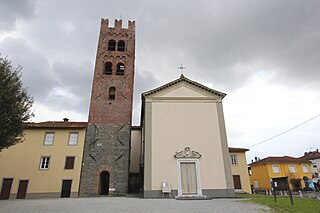
The Pieve di San Frediano is a rural parish church, originally founded in the 8th century, and located in Lunata, a hamlet of the town of Capannori, province of Lucca, region of Tuscany, Italy.



























